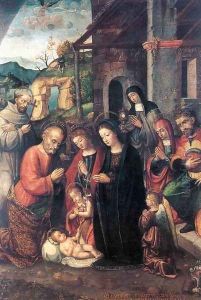Bernardino Fasolo Paintings
Bernardino Fasolo was an Italian painter active during the Renaissance period, born in 1489 in the town of Pavia, located in the Lombardy region of Italy. His life and work are often overshadowed by the towering figures of the Renaissance such as Leonardo da Vinci, Michelangelo, and Raphael, but Fasolo contributed significantly to the art scene of his time, especially within the scope of his regional influence in Lombardy and Genoa.
Fasolo's artistic journey is somewhat less documented compared to his more famous contemporaries, which has led to a modest historical footprint. However, what is known illustrates a painter deeply embedded in the cultural and artistic movements of early 16th century Italy. He was primarily known for his religious compositions, frescoes, and altarpieces, which exhibit the characteristic Renaissance blend of realism, attention to human emotion, and a harmonious use of color.
The style of Bernardino Fasolo shows a clear influence from the Lombard school of painting, which was known for its detailed landscapes and intimate domestic scenes, as well as from the Venetian school, celebrated for its vibrant color palette and masterful light treatment. Despite these influences, Fasolo managed to carve out his own stylistic niche, particularly in his approach to narrative storytelling within his religious and mythological works.
One of the most significant aspects of Fasolo’s career was his contribution to the decoration of churches and public buildings in Pavia and Genoa. His works for these projects often depicted scenes from the life of Christ, the Virgin Mary, and various saints, executed with a depth of feeling and a delicacy of touch that spoke to his devoutness and sensitivity as an artist.
Bernardino Fasolo's death in 1526 marked the end of a career that, while not as celebrated as some of his peers, played a role in the rich tapestry of Renaissance art. His legacy, though not extensive, remains a testament to the diversity and depth of talent that flourished in Italy during one of the most vibrant periods in the history of art.
